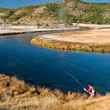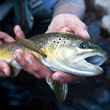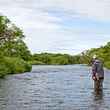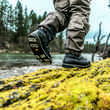
Despite being a land of staggering plenty, Alaska's southeast is facing a number of challenges. Proposals for new mining operations and hydroelectric dams are looming and the logging industry -- a spectacular and perpetual loser both environmentally and economically -- is looking to re-establish operations in the Tongass National Forest after largely being set aside several decades ago. As a result, a growing number of local, regional and national groups continue their efforts to protect the habitat of the Tongass the myriad of life that depends on it, though not without significant hurdles still ahead.
The logic seems simple. In a region where virtually every facet of the economy -- particularly the salmon and tourist industries -- is dependent either directly or indirectly on the bounty of the forest that surrounds and encompasses it, the necessary argument seems to require little more sophistication than "don't shit where you eat." But, even in Alaska's southeast, where support for measures like the Tongass 77 -- which seeks increased protection from development like logging for 77 watersheds researchers have identified as the most valuable within the boundaries of the national forest -- is strong, not everyone is on board. Not even amongst fishermen.
Any lack of support for measures protecting the invaluable habitat of the Tongass may simply be a result of perception, rather than a gulf on matters of principle importance. Factors such as a growing national distrust of governmental regulation play a role, but perhaps more at the root of any inability to gather at the table may be how many view the way they interact with the opulence of the Tongass. As one local fisherman, who supports measures like the Tongass 77 noted, "fishermen -- like loggers -- are resource extractors. There's an inherent hesitancy amongst resource extractors of all flavors and colors to support policies that seek to limit or constrain extraction, whether that resource is lumber or fish, regardless of how common sense those policies may be."
Also at play is the fact that, for now, the salmon and the other species of the Tongass are thriving, making it difficult for some to see the need to put regulations in place, difficult for some to agree on the likely future facing the region. The reality here, however, is that seeing the need for taking steps to protect and conserve the rich habitat of Alaska's southeast doesn't require a subjective leverage of foresight. Rather, it requires only hindsight. The future facing the Tongass, should efforts to protect its most valuable habitat fail, is already well written in the past of vast swaths of the Pacific Northwest (more on that here).
The Tongass of today is one that fuels an ecosystem, an economy and a variety of cultures, and begs to be explored by those that have a love of wild places. The hope, is that the Tongass of today will persist indefinitely, continuing to drive a vibrant and healthy southeastern Alaska.






































































Add new comment